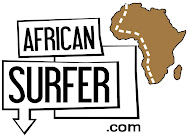My friend, Jocelyn, came with Maxi and I to look at the waves yesterday. The foamy mess of white water and brown seaweed inspired a frown. “It’s two foot and ONSHORE,’ I said.
“What do you mean onshore?” she asked. My summary was a bit vague, I suppose.
“Explain yourself,” she added.
Maxi wasn’t about to sit around and listen to me babble on about surfing. So he got out the car to chase seagulls and pee on stuff.
“On shore,” I explained, “is wind that blows from the ocean towards the land (a sea breeze). Onshore wind has a crumbling affect on waves, collapsing them prematurely and churning the water into pea soup at the same time.
“Offshore wind has the opposite affect. It holds the wave’s shape as it peels over a sand bar or reef, giving it a cylindrical form.
“ONSHORE wind: think of Donald Trump’s comb over hair style. OFFSHORE wind: think of a 90’s kuif. It’s just like that.” I said.
“Oh,” said Joc, not entirely won over by my explanation.
Meanwhile, Maxi seemed to be making progress with the sea gulls. He’d infiltrated a small flock convening near the water’s edge. He was standing on his hind legs, trying to strike up conversation with a loner seagull on the outskirts of the group.
“Ok,” said Joc, “and what about feet— 2 feet is tiny. Those waves look bigger than 2 feet.”
This is a timeless question. I’m not sure why waves have always been measured in feet. Some people say it’s because you gauge a wave’s size from the back; hence the reason a chest high wave is considered a solid 2 footer.
There are different variations of feet, too. Surfers talk about waves being measured in Hawaiian feet. In other words a 3 foot Hawaiian wave would be considered 5 or 6 feet else where in the world. Or something like that.
Grant Jack, a knee boarder from PE who now lives in London, once said that waves should be measured in “Scary’s”.
Let me explain: Because waves in PE rarely reach the 10 foot mark, it seems logical to have a scale out of 10. So a 3 foot wave is surfable and not very scary, but not 3 geometric feet. It is, accurately said, 3 out of 10 Scary’s.
If you lived in Cape Town, where waves up to 30 feet are ridden, the Scary scale still holds water. A 15 footer, for example, will be measured out of 20; its bigger than 15 actual feet, but not the biggest of waves available. So you say 15 feet. That’s 75% scary within the realm of its height divisions. You couldn’t say it’s a 75%’er, so 15 feet will do.
“Am I making sense?” I asked Joc after explaining this.
“Not really, but sort of,” she replied.
Maybe that’s it. The scales and units we use to measure waves and conditions are not always accurate. They make sense in some ways, but not always. “Not really, but sort of,” is probably getting it just right.
With that, Maxi returned to the car with a mouth full of sand. The shy seagull he tried to catch for lunch turned out to be black belt in karate. Max tells me he was lucky not to have been fed his tail.
Lastly, on the topic of big waves:
Grant Baker, a Cape Town-ian big wave surfer, has been invited to compete in the Quicksilver “In Memory of Eddie Aikau”. It’s the longest running and most prestigious big wave event, held at Waimea Bay in Hawaii. That’s a great achievement and South Africa should be very proud.
Thursday, November 6, 2008
Subscribe to:
Post Comments (Atom)


No comments:
Post a Comment